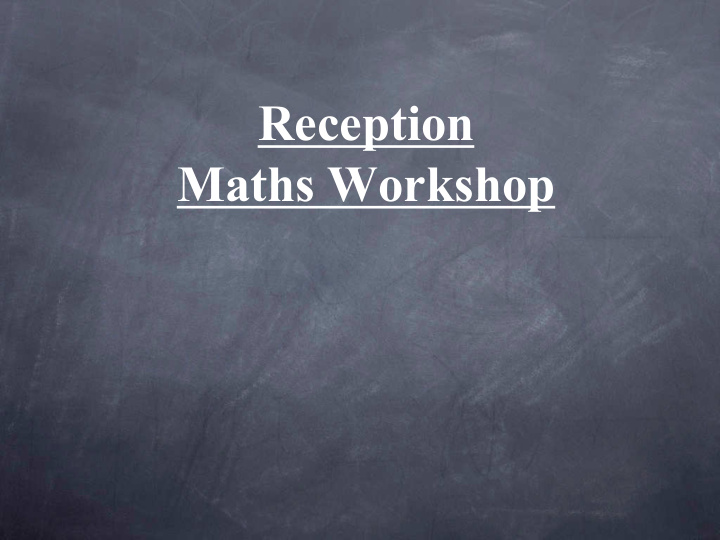



Reception Maths Workshop
Maths in Early Years • Maths in the Early Years builds an important foundation for number, space shape and measure as well as problem solving in Key Stage 1 and beyond. • Work is based on first hand experiences in real life situations. • Most importantly, it is about having fun and enjoying using numbers and solving everyday problems- how many children are in school today? Have we got enough apples?
What we use: • The EYFS Guidance. • Oxfordshire Termly overview of mathematical skills. • Numbers and Patterns. • The Hamilton Trust. • Educational websites.
How we teach maths in Reception • Through structured play and child initiated learning. • Adult led activities- whole class and differentiated maths groups. • Using counting rhymes, stories and games. • Through everyday routines. • We encourage the use of cubes, compare bears, fingers, number fans, number lines up to 10 and 20. • We talk about 1 more/ 1 less with numbers 1-20
Maths through play and practical experiences: • As part of everyday routines- how many children can play? How many boys/girls are here today? How many children are there altogether? • In all areas both inside and outside. • Role play- shops, doctors surgeries, building sites, acting out stories . • Outdoor play- sand, water, games, number hunts etc • Rhymes, songs, stories. • Games.
Maths in action!
There are 2 aspects of mathematical understanding in Early Years Foundation Stage: • Numbers as labels for counting and calculating • Shape, space and measure.
Progression in Number Say numbers in order. • Recognise numerals and add the correct • number of objects to a numeral. Develop problem solving skills- how many • more apples do we need? Identify more and less, then 1 more 1 less • Begin to relate addition to combining two • groups of objects and subtraction to ‘taking away’ Beginning to record what they know- • introducing number sentences
Early learning goal expectations in number for the end of Reception are: • Children count reliably with numbers from 1 to 20, place them in order and say which number is 1 more or 1 less than a given number. • Using quantities and objects, they add and subtract 2 single digit numbers and count on or back to find the answer. • They solve problems, including doubling, halving and sharing.
Shape, Space and Measure and first stages in reception: Shape (2D and 3D) - Identifying, naming and describing some common 2D • and 3D shapes (round/curved/straight/edge/corner/face). Pattern - Identifying, creating and recreating and describing simple patterns . • Position - Using and understanding positional language (on, under, in, next to, • between, in front, behind). Length - Ordering items by length or height and using language of length and • height (long/er/est, short/er/est, tall/er/est, big, little, wide, narrow). Weight - Ordering items by weight and using language of weight • (heavy/ier/iest, light/er/est). Capacity - Ordering items by capacity and using language of capacity • (full/empty /half full/more/less). Time - Use everyday language related by time/ Measure short periods of time/ • Order and sequence familiar events. (hours, minutes, seconds, quick, slow, first, now, next, after). Money - Recognise and name some coins learn to use them in practical • experiences./Begin to use everyday language related to money (change, pounds, coin, how much?)
Early learning goal expectations in SSMfor the end of Reception are: • Children use everyday language to talk about size, weight, capacity, position, distance, time and money to compare quantities and objects and to solve problems. • They recognise, create and describe patterns. • They explore characteristics of everyday objects and shapes and use mathematical language to describe them.
A few ideas around SSM you can do at home: • Helping with the cooking by weighing ingredients, measuring liquids, and setting the timer on the cooker. • Matching and sorting socks by colour/pattern/size. • While shopping discuss 3D shape names of packaging/food items. • Helping you to find the correct coin to pay for an item in a shop. • Measuring to see who has the biggest hands/feet in your family. • Use the stopwatch or timer on your mobile phone to see how long it takes to tidy up or get ready for bed. • Talk about the different shapes you make – rectangle, square, triangle – when you fold a tablecloth, newspaper or duvet cover. • When you are out for a walk play shape ‘I-Spy’. • Look out for and talk about the different patterns you see around you.
Going on a shape hunt!
How you can help... Do little and often. • Use every day experiences- laying the table, • sorting socks. Praise- have fun together. • Play lots of games. • Completing the maths challenges sent home. • Remember most of all to have FUN ! •
Recommend
More recommend